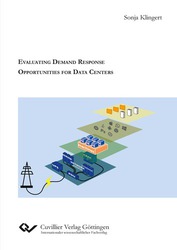| Departments | |
|---|---|
| Book Series (96) |
1378
|
| Nachhaltigkeit |
3
|
| Gesundheitswesen |
1
|
| Humanities |
2364
|
| Natural Sciences |
5406
|
| Mathematics | 229 |
| Informatics | 319 |
| Physics | 980 |
| Chemistry | 1363 |
| Geosciences | 131 |
| Human medicine | 243 |
| Stomatology | 10 |
| Veterinary medicine | 108 |
| Pharmacy | 147 |
| Biology | 835 |
| Biochemistry, molecular biology, gene technology | 121 |
| Biophysics | 25 |
| Domestic and nutritional science | 45 |
| Agricultural science | 1004 |
| Forest science | 201 |
| Horticultural science | 20 |
| Environmental research, ecology and landscape conservation | 148 |
| Engineering |
1793
|
| Common |
98
|
|
Leitlinien Unfallchirurgie
5. Auflage bestellen |
|
Advanced Search
Evaluating Demand Response Opportunities for Data Centers (English shop)
Sonja Klingert (Author)Preview
Table of Contents, PDF (30 KB)
Extract, PDF (6.2 MB)
Data center demand response is a solution to a problem that is just recently emerging: Today’s energy system is undergoing major transformations due to the increasing shares of intermittent renewable power sources as solar and wind. As the power grid physically requires balancing power feed-in and power draw at all times, traditionally, power generation plants with short ramp-up times were activated to avoid grid imbalances. Additionally, so-called demand response schemes may incentivize power consumers to manipulate their planned power profile in order to activate hidden sources of flexibility. The data center industry has been identified as a suitable candidate for demand response as it is continuously growing and relies on highly automated processes.
The presented thesis exceeds the related work by creating a framework for modeling data center demand response on a high level of abstraction that allows subsuming a great variety of specific models. Based on a generic architecture of demand response enabled data centers this is formalized through a micro-economics inspired optimization framework that generates technical power flex functions and an associated cost and market skeleton.
This is evaluated through a simulation based on 2014 data from a real HPC data center in Germany, implementing two power management strategies, namely temporal workload shifting and manipulating the CPU frequency. The flexibility extracted is then monetized on two German electricity markets. As a result, in 2014 this data center would have achieved the largest benefit by changing from static electricity pricing to dynamic EPEX prices without changing their power profile. Through demand response they might have created an additional gross benefit of 4% of the power bill on the secondary reserve market. In a sensitivity analysis, however, it could be shown that these results are largely dependent on specific parameters as service level agreements and job heterogeneity. The results show that even though concrete simulations can evaluate demand response activities of individual data centers, the proposed modeling framework helps to understand their relevance from a system-wide viewpoint.
| ISBN-13 (Hard Copy) | 9783736973305 |
| ISBN-13 (eBook) | 9783736963306 |
| Final Book Format | A5 |
| Language | English |
| Page Number | 286 |
| Lamination of Cover | matt |
| Edition | 1 |
| Publication Place | Göttingen |
| Place of Dissertation | Mannheim |
| Publication Date | 2020-12-03 |
| General Categorization | Dissertation |
| Departments |
Informatics
|
| Keywords | Data Center, Demand Response, Data Center Demand Response, Ancillary Services, Regulation Services, Smart Grid, Power Grid, Electricity Grid, EPEX, EPEX Stock Market, Day Ahead Market, Secondary Reserve Market, Electricity Market, Electricity System, Energy Market, Energy System, Power Market, Power System, Energy Informatics, Micro Economics, Information Systems, Electricity Demand, Demand Side Flexibility, Demand Adaptation, Workload Shifting, Temporal Workload Shifting, Power Management, DVFS, CPU Frequency, Frequency Scaling, Data Center Simulation, Data Center Simulation Framework, Architecture Framework, Data Center Model, Data Center Architecture, Data Center Cost, Data Center Benefit, Data Center Electricity Cost, Electricity Cost, Electricity Bill, Renewable Energy, Rechenzentrum, Lastmanagement, Demand Response, Demand Response Modell, Demand Response Management, Energiemanagement, Systemdienstleistungen, Sekundärregelleistung, Reservemarkt, Smart Grid, EPEX Day-Ahead, Strommarkt, Stromsystem, Energiesystem, Stromnetz, Anschlussleistung, Energieinformatik, Wirtschaftsinformatik, Stromnachfrage, Adaptive Stromnachfrage, Flexibilität, Nachfrage-Flexibilität, Adaptivität, Stromnachfragemanagement, Arbeitslast, Arbeitslastverlagerung, DVFS, Serverfrequenz, Frequenzskalierung, Rechenzentrumssimulation, Lastsimulation, Mikroökonomie, Lastmanagementmodell, Rechenzentrumsmodell, Rechenzentrumsarchitektur, Rechenzentrumskosten, Rechenzentrumsgewinn, Rechenzentrumsstromkosten, Stromrechnung, Erneuerbare Energie, Energiequelle, Stromerzeugung, Raumklimagerät, Stromverbraucher, Energieplan, Energiebedarf, Stromnachfrage, Stromversorger |
| URL to External Homepage | https://www.bwl.uni-mannheim.de/en/becker/team/dipl-pol-sonja-klingert/ |








